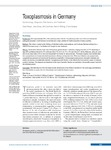Toxoplasmosis in Germany: Epidemiology, Diagnosis, Risk Factors, and Treatment
Pleyer, Uwe
Groß, Uwe
Schlüter, Dirk
Wilking, Hendrik
Seeber, Frank
Background: With approximately 30% of the world population infected, Toxoplasma gondii is one of the most widespread pathogenic parasites in both humans and animals and a major problem for health economics in many countries.
Methods: This review is based on the findings of individual studies, meta-analyses, and Cochrane Reviews retrieved by a selective literature survey of the Medline and Google Scholar databases.
Results: Current data indicate a high rate of Toxoplasma gondii infection in Germany, ranging from 20% to 77% depending on age (95% confidence interval for 18- to 29-year-olds [17.0; 23.1]; for 70- to 79-year-olds [72.7; 80.5]). Male sex, caring for a cat, and a body mass index of 30 or more are independent risk factors for seroconversion. Postnatally acquired (food-related) infection is predominant, but maternal-to-fetal transmission still plays an important role. While most infections are asymptomatic, congenital toxoplasmosis and reactivated Toxoplasma encephalitis in immunosuppressed persons (transplant recipients and others) are sources of considerable morbidity. Toxoplasma gondii infection of the retina is the most common cause of infectious uveitis in Germany. The diagnosis and treatment of this type of parasitic infection are particular to the specific organs involved in the individual patient.
Conclusion: Desirable steps for the near future include development of an effective treatment for the cystic stage and identification of biomarkers to assess the risk of reactivation and predict the disease course.
Dateien zu dieser Publikation
Keine Lizenzangabe

